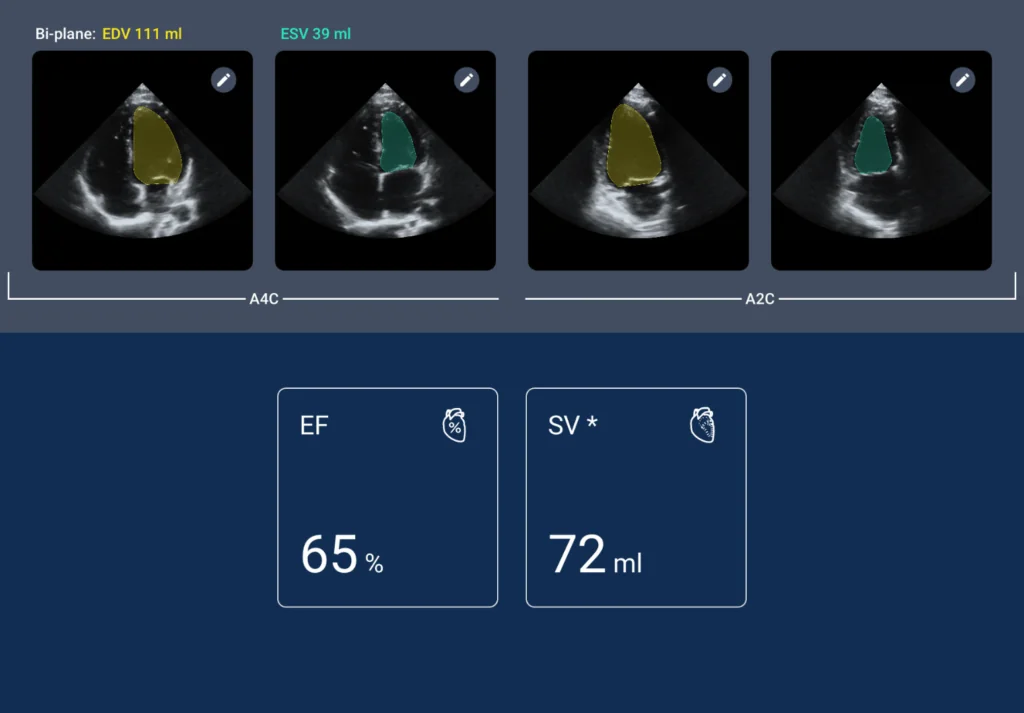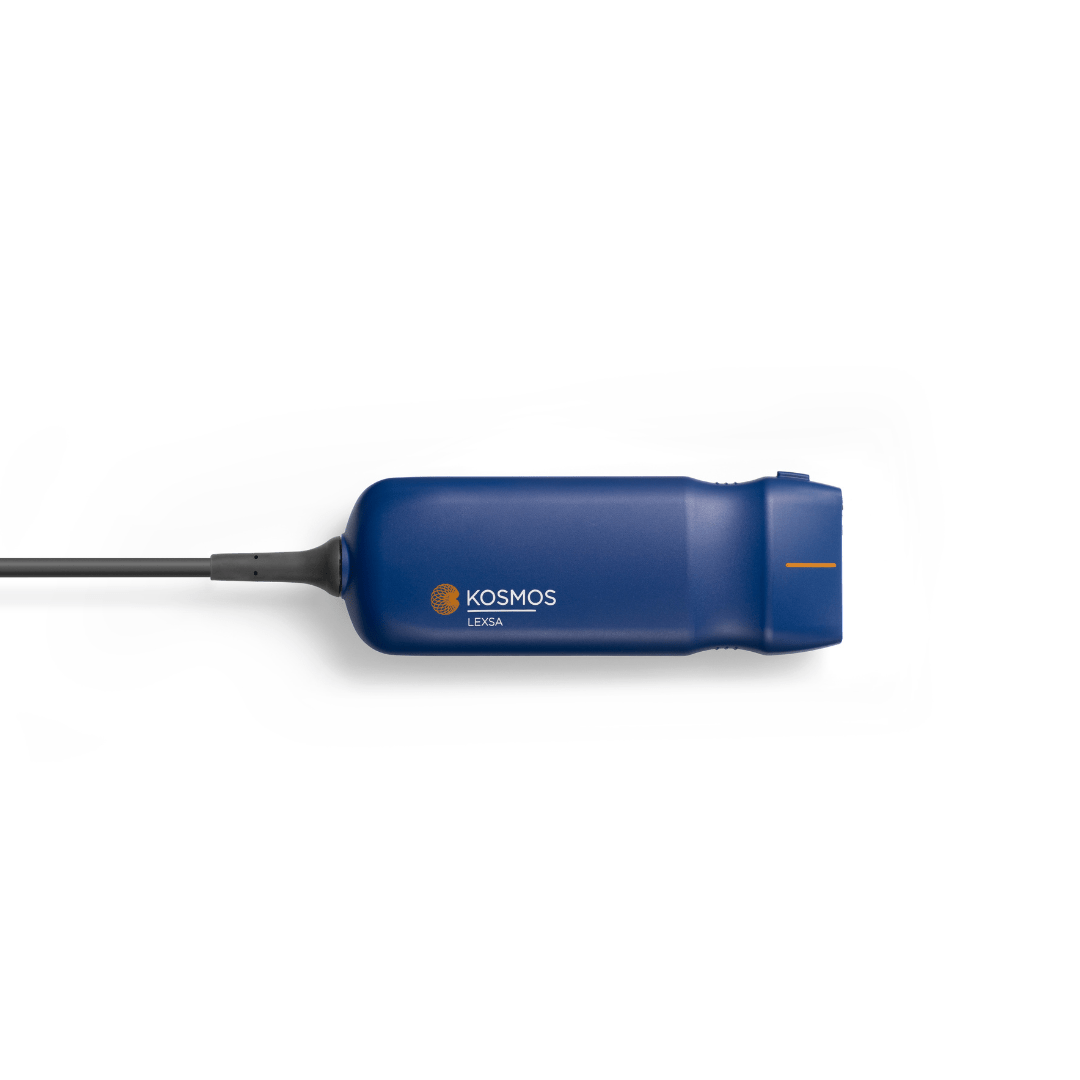Lung Ultrasound in Heart Failure Management: Enhancing Diagnosis, Monitoring, and Patient Outcomes in Critical Care
Heart failure (HF) represents a significant clinical problem affecting an estimated 60 million people worldwide who require care. It is a multifaceted disorder in which the failure of the heart to pump blood adequately causes fatigue, shortness of breath, and fluid retention, among many symptoms.
HF is associated with high hospitalization rates, readmission, and mortality, making it effective in critical care management of considerable interest. Due to its chronic nature, an accurate diagnosis and timely, regular monitoring are imperative to improve outcomes in HF patients. Correctly identifying pulmonary congestion is critical in HF management as the etiological process often causes acute decompensation and subsequent symptom worsening.
Conventional diagnostic tools include clinical examination, chest radiography, and biomarkers such as NT-proBNP. Thus, new diagnostic strategies are necessary to improve sensitivity and specificity.
In patients with HF, lung ultrasound (LUS) or pulmonary ultrasound have become necessary, non-invasive instruments to recognize and monitor pulmonary congestion. These techniques can be performed quickly at the bedside, offering valuable insights regarding lung fluid accumulation. LUS has a much higher sensitivity than chest X-rays for pulmonary congestion by identifying B-lines (vertical artifacts), which indicate extravascular lung water [1].
LUS is particularly valuable in settings such as the emergency department, intensive care units, and outpatient settings, where urgency in decision-making is of the utmost importance. Lung ultrasound serves as a utility beyond diagnosis and is also increasingly used for diuretic therapy guidance, congestion resolution monitoring, and adverse outcome prediction. LUS-guided management is able to improve patient care in the long term, with studies showing reductions in hospital readmissions and improvement in long-term prognosis [1].
The following article will detail the science underlying lung ultrasound, its application to the evaluation and management of acute and chronic HF, and practical suggestions for adapting LUS into clinical practice.
Additionally, we will discuss key findings from the latest clinical consensus on LUS in HF, providing critical insights for healthcare professionals managing HF patients in critical care settings.
Table of contents
- Lung Ultrasound in Heart Failure Management: Enhancing Diagnosis, Monitoring, and Patient Outcomes in Critical Care
- Understanding Heart Failure and Pulmonary Congestion
- Lung Ultrasound in Heart Failure: The Science and Mechanism
- Clinical Applications of Lung Ultrasound in Heart Failure Management
- Integration of Lung Ultrasound with Echocardiography in Heart Failure
- Best Practices for Performing Lung Ultrasound in Heart Failure
- Limitations and Challenges in Lung Ultrasound for Heart Failure
- Future Directions and Research Opportunities
- Conclusion
- References
Understanding Heart Failure and Pulmonary Congestion
Definition and Pathophysiology of Heart Failure
Heart failure (HF), including a wide spectrum of heart dysfunctions, is defined as a complex clinical condition with a characteristic of a heart’s incapability to pump enough blood to satisfy the metabolic requirements of the body.
It is typically associated with raised cardiac filling pressures, impaired cardiac output, and system congestion. HF is characterized pathophysiologically by structural and functional abnormalities of the heart that compromise the ability of the ventricle to eject blood or fill. These mechanisms cause fluid accumulation in the lungs and peripheral tissues, leading to the principal symptoms that HF patients experience [2].
Uncontrolled congestion, especially in intravascular tissue, is a red flag for HF progression. Because pulmonary congestion impairs gas exchange in the lungs and drives important HF symptoms like breathlessness and fatigue, it is especially concerning [3,1].
Link Between Heart Failure and Pulmonary Congestion
Pulmonary Congestion is a characteristic feature of advancing HF, owing to elevated left ventricular filling pressures. When left ventricular systolic function is impaired, blood is congested into the pulmonary vasculature, resulting in serosanguinous fluid extravasation from blood vessels into the lung interstitium and filling of alveoli.
This contributes to the hallmark symptoms of HF, such as dyspnea (shortness of breath), orthopnea (dyspnea while lying flat), and reduced exercise tolerance [4]. The early stages of pulmonary congestion are often without symptoms, yet its early identification may be key to avoiding acute decompensation [1].
Clinical Signs and Symptoms of Pulmonary Congestion
Patients with pulmonary congestion typically present with dyspnea, orthopnea, and paroxysmal nocturnal dyspnea. Other important clinical findings: crackles on lung auscultation, jugular venous distension, and peripheral edema. These symptoms are, however, not specific and may overlap with other respiratory disorders, leading to diagnostic challenges [5,1].
Conventional Diagnostic Methods for Detecting Pulmonary Congestion
Standard approaches for the detection of pulmonary congestion are via clinical examination, chest radiography, and echocardiography. Chest X-rays can show pulmonary edema but are much less sensitive to subclinical congestion. Although echocardiography brings new insight into cardiac structure and function, it may overlook precursors of pulmonary congestion unless combined with ancillary imaging methods.
Most notably, natriuretic peptides, including B-type natriuretic peptide (BNP) and the aminoterminal prohormone for BNP (NT-proBNP), are widely utilized biomarkers in HF diagnosis, but they demonstrate greater utility in ruling out HF than confirming pulmonary congestion [6,1].
Lung ultrasound (LUS) has arisen as a better method for recognizing pneumatic congestion. LUS allows for the real-time assessment of pulmonary congestion through the identification of an artifact: B-lines, which are vertical artifacts that reflect extravascular lung water [7], making LUS non-invasive and radiation-free with high sensitivity [1].
Challenges in Early and Accurate Identification of Pulmonary Congestion
Although there have been advances in diagnostic techniques, early detection of pulmonary congestion in patients with HF still appears difficult. The variability in clinical presentation, in combination with the limitations of conventional diagnostic tools, often results in delay.
The distinction between intravascular and tissue congestion is particularly challenging and relies on a multifactorial approach for diagnosis, including clinical history, imaging, and laboratory biomarkers. Assessment of congestion is inherently dynamic (and thus complicated), which means regular monitoring is required for optimized HF management [1,8].
Advances in diagnostic tools, particularly lung ultrasound, have improved the ability to detect and manage pulmonary congestion effectively. Integrating these methods with traditional diagnostics is critical for ensuring early intervention, improving patient outcomes, and reducing HF-related hospitalization [1].
Lung Ultrasound in Heart Failure: The Science and Mechanism
Lung ultrasound (LUS) plays an increasingly important role in heart failure (HF) evaluation as a non-invasive, fast, and accurate method to assess pulmonary congestion. The ultrasound of the lung bases has excellent sensitivity for the detection of pulmonary fluid overload and is applicable in acute and chronic HF management. LUS is now well established as having superior diagnostic performance compared to traditional methods such as chest X-rays and clinical examination in the detection of pulmonary congestion[9,1]. Its bedside use has become essential in emergency, critical care, and outpatient settings.
Technical Overview of Lung Ultrasound Imaging
Use of Phased- Array and Convex Transducers
LUS most commonly uses phased-array and convex transducers, both of which are conducive to cardiopulmonary imaging. Phased-array transducers are widely used in cardiac imaging and have a small footprint suitable for intercostal scanning. For abdominal imaging, convex transducers are used, but we have found them to be even better for lung evaluation and may better visualize B-lines with fewer artifacts [10,1].
Selecting the appropriate transducer is essential for optimal imaging. In emergency settings and for acute cases where image quality is important in small spaces, a phased-array probe, which provides high-resolution images, is favored, while convex probes are generally preferred in stable patients, where more comprehensive imaging leads to more useful information [1].
Image Interpretation
- Pleural Line: This is seen as a bright, horizontal, hyperechoic structure beneath the ribs. The normal pleural line is smooth and demonstrates synchronized motion with respiration (lung sliding).
- A-lines: These are horizontal, repetitive artifacts parallel to the pleural line. The patient has a normally aerated lung with no evidence of the presence of fluid.
- B-lines: Vertical, laser-like reverberation artifacts that originate from the pleural line and connect with the bottom of the ultrasound screen. B-lines are the most common sign associated with pulmonary congestion and a reliable marker of extravascular lung water [11,1].
Key Indicators on Lung Ultrasound for Heart Failure Patients
B-lines as a marker for pulmonary congestion
A major diagnostic sign in HF patients using LUS is the B-lines. Their presence, numbers, and distribution correlate closely with the degree of pulmonary congestion. Acute HF patients usually exhibit multiple peripheral B-lines that reverse with a decrease in extravascular lung water following decongestive therapy [12]. Dynamic assessment of B-line resolution during treatment provides clinicians with a useful means of assessing treatment efficacy and predicting patient outcomes [1].
Pleural effusion detection
LUS is very sensitive to pleural effusion (PE), a common macro-anatomic finding in patients with advanced HF. Pleural effusions show up as an anechoic (dark) space above the diaphragm and are usually associated with decreased aeration of the lungs. Pleural effusion is critical for fluid overload assessment and management through drainage in the more severe cases [11,1].
Distinguishing Cardiogenic Versus Non-Cardiogenic Causes of Pulmonary Congestion
LUS can differentiate between cardiogenic pulmonary edema and non-cardiogenic causes such as acute lung injury or pneumonia. In HF, however, B-lines are usually diffuse and bilateral, while non-cardiogenic conditions display a patchy or asymmetric distribution of B-lines.
Integrating LUS with echocardiographic findings and clinical context may optimize diagnostic accuracy and direct targeted therapies [8,1].
Clinical Applications of Lung Ultrasound in Heart Failure Management
Lung ultrasound (LUS) is emerging as a promising diagnostic, monitoring, and prognostic tool in the setting of heart failure (HF). Its capacity to evaluate pulmonary congestion with greater precision compared with conventional modalities renders it invaluable in the management of both acute and chronic HF. The LUS allows clinicians to obtain real-time information on patient status from major markers, including B-lines and pleural effusion, which improves the accuracy of diagnosis and treatment outcomes [1].
Making a Diagnosis
Identifying Acute Pulmonary Congestion in Emergency Settings
In emergency situations where there is a need for timely and precise diagnosis, LUS shows promising results in the detection of acute lung congestion. LUS is capable of detecting B-lines, vertical, hyperechoic artifacts indicative of accumulation of extravascular lung water. B-lines, a qualitative and quantitative assessment of pulmonary congestion, correlate strongly with pulmonary congestion, enabling clinicians to rapidly and accurately diagnose acute decompensation HF [9].
LUS has been found to be superior to clinical examination and chest radiography in diagnosing acute pulmonary congestion, especially in patients presenting with dyspnea in the emergency department [10,1].
Differentiating Cardiogenic pulmonary edema from other conditions
LUS also helps differentiate cardiogenic pulmonary edema from noncardiogenic causes of respiratory distress, such as ARDS or pneumonia. Cardiogenic edema is typically bilateral with smooth, symmetrical B-lines and preserved lung sliding, while asymmetric or focal B-lines and irregular pleural lines are characteristic of ARDS or pneumonia [8]. The distinction is critical for enabling targeted therapies and improving outcomes [1].
Advantages of Lung Ultrasound Over Chest X-ray and CT Imaging
LUS has the main advantages over chest X-ray and CT imaging. It is radiation-free, non-invasive, low-cost, portable, and offers immediate bedside results- all useful features for a technology to be deployed in critically ill patients. In addition, the LUS can identify pulmonary congestion at an earlier stage than it may appear on a chest X-ray, thereby increasing diagnostic sensitivity [13].
Monitoring and Treatment Guidance
Monitoring Decongestion During Acute Heart Failure Treatment
Findings suggest that LUS is useful for monitoring pulmonary congestion resolution in the acute HF setting. Diminution in B-lines after diuretic predicts better clinical outcomes. LUS-guided monitoring enables real-time evaluation of decongestion, aiding clinicians in the tailoring of fluid management strategies [14,1].
Assessing B-lines to Titrate Diuretic Therapy
This quantification of B-lines for LUS guides diuretic adjustment. Such an approach mechanism is the best balance between decongestion and over-diuresis risk, thus reducing the risk of complications such as electrolyte imbalance and renal dysfunction [15,1].
Predicting Outcomes by Evaluating Residual Congestion Before Discharge
LUS Residual B-Lines on LUS before discharge from hospitals have been associated with an increased risk of readmission and adverse outcomes. Recognizing patients who have residual congestion allows us to tailor interventions to reduce complications after discharge [16,1].
Prognostic Value
Correlation Between Persistent B-lines and Increased Risk of Readmission and Mortality
In patients with HF, persistent B-lines are independently predictive of poor outcomes. It has been shown that patients with persistence of B-lines after treatment have increased mortality and readmission rates, highlighting the prognostic value of LUS [17,1].
Evidence Supporting Lung Ultrasound in Long-Term Risk Stratification
LUS has proved to be revolutionary in determining long-term risk stratification in HF patients. LUS enables clinicians to identify high-risk patients requiring intensified management strategies by recognizing subclinical congestion during routine follow-up [15,1].
Integration of Lung Ultrasound with Echocardiography in Heart Failure
Lung Ultrasound (LUS) per se has shown to be especially powerful when integrated with echocardiography for comprehensive assessment of heart failure (HF) patients. This dual strategy allows for improved accuracy in diagnosing conditions, developing treatment plans, and understanding systemic congestion mechanisms [1].
Benefits of Combining Lung Ultrasound with Echocardiography
LUS shines in pulmonary congestion detection via B-lines visualization as a hallmark sign of extravascular lung water. The utility of ultrasound and echocardiography becomes even more powerful when used in combination as it allows clinicians to refine the differential diagnosis between cardiogenic and non-cardiogenic pulmonary conditions based on the detailed assessment of cardiac function. This leads to an increase in the accuracy of the diagnosis of acute decompensated heart failure in both emergency and outpatient settings [18].
Enhancing Diagnostic Accuracy and Treatment Decision-Making
LUS allows for real-time pulmonary congestion visualization and can be complementary to echocardiographic findings suggesting reduced ejection fraction or diastolic dysfunction. This provides added value as clinicians can track decongestion real-time during treatment and improve their fluid handling strategies. LUS associated with echocardiography has been proven to provide better outcomes due to early intervention and personalized treatment modifications by precise treatment [10].
Role in Assessing Systemic Congestion
Echocardiography is useful in assessing systemic congestion by evaluating inferior vena cava (IVC) size and collapsibility. Assessment of the ultrasound findings helps determine fluid management approach in HF patients [19] and provides a more comprehensive evaluation of congestion status.
Best Practices for Performing Lung Ultrasound in Heart Failure
Lung ultrasound (LUS) has proved to be a key tool to assess pulmonary congestion in heart failure (HF) across the spectrum of disease, and most clinical studies have confirmed it as a reliable method to check the response of an HF patient to treatment [1].
Recommended scanning Protocols
The B-Zone protocol is widely recommended for comprehensive assessment, as it effectively balances through evaluation with clinical efficiency. This method involves scanning four zones on each side of the chest, improving the detection of pulmonary congestion [20]. In emergency settings, the 4-zone protocol is a more rapid way of yielding insights in time-sensitive scenarios [1].
Patient Positioning and Transducer Settings
To achieve optimal imaging, the patient should preferably be in the supine position, which has been reported to induce the highest B-line scores and visualization of pulmonary congestion [2,1]. Scanning through intercostal spaces with a 3.5 to 5.0 MHz cardiac transducer can provide sufficient image quality for B-line detection.
Practical Tips for Identifying and Quantifying B-lines
B-lines are vertical, hyperechoic lines that coexist with respiration. For an accurate interpretation, the scanning technique and positioning should be consistent. And with proper training, even novice operators can learn to reliably identify and quantify B-lines [22]. By conforming to these best practices, clinicians could optimize the diagnostic value and usefulness of LUS in treating heart failure patients.
Limitations and Challenges in Lung Ultrasound for Heart Failure
Lung ultrasound (LUS) has taken on increasing importance in the management of heart failure (HF), but it still has various pitfalls and challenges.
Operator Dependency and Training Requirements:
LUS accuracy largely depends on the operator learning curve. Understanding can also lead to increased variance in results, making their use in routine practice limited [8].
Variability in B-line Interpretation and Equipment Differences:
There is a high operator dependency and equipment dependency. Differences in ultrasound equipment settings can also play a role in a lack of diagnostic consistency [23].
Challenges in Distinguishing Overlapping Pulmonary Conditions:
Distinct sonographic features allow differentiation between HF-associated pulmonary congestion and other conditions like pneumonia or COPD [24]. Standardized protocols and improved training may help overcome these challenges and improve the role of LUS in HF care.
Future Directions and Research Opportunities
Although more than a decade has passed since the utility of lung ultrasound (LUS) as an adjunct to physical examination in heart failure (HF) management has been recognized, several key evidence gaps remain, and opportunities for expansion exist.
Gaps in Evidence Regarding LUS-Guided Treatment Strategies:
While LUS has demonstrated value in detecting pulmonary congestion, its optimal integration with other hemodynamic parameters for guiding treatment remains unclear. In emergency and outpatient settings, mixed evidence has emerged surrounding outcome improvement, with data prominent in the literature signaling further investigation is warranted [14,1].
Research Needs for Outpatient Validation:
Although LUS has the potential to dictate treatment strategies amongst chronic HF patients in outpatient settings, the effects of implementing LUS on avoiding hospitalizations and improving long-term outcomes are yet unclear, leading to the need for further research in this field [15].
Further investigation in these domains will improve the utility of LUS in HF management.
Conclusion
Lung ultrasound (LUS) has become an important diagnostic, prognostic, and monitoring tool in patients with heart failure (HF) [1-4]. With its high sensitivity for pulmonary congestion, it is superior to conventional methods, including chest X-ray, for the evaluation of acute and chronic HF [26].
LUS facilitates clinicians in the early detection of congestion signs, optimization of diuretic therapy, and prediction of adverse outcomes through the identification of B-lines and pleural effusion, therefore improving patient management.
For critical care professionals, LUS offers rapid bedside assessment capabilities, providing immediate insights into pulmonary and systemic congestion. Its non-invasive nature and ease of use make it an essential tool in both acute and chronic heart failure settings, improving clinical decision-making in emergency departments, intensive care units, and outpatient care.
The addition of lung ultrasound and pulmonary ultrasound into the routine evaluation of patients with suspected HF should augment diagnostic accuracy, lower rates of hospital readmission, and improve the long-term prognosis. With increased training programs and standardization of protocols, its clinical impact shall be further enhanced.
References
1. Gargani et al. (2023). Lung ultrasound in acute and chronic heart failure: A clinical consensus statement of the European Association of Cardiovascular Imaging (EACVI). European Heart Journal Cardiovascular Imaging, 24(12), 1569–1582.
2. Em et al. (2020). Congestion in heart failure: A contemporary look at physiology, diagnosis and treatment. Nature Reviews. Cardiology, 17(10).
3. Pandhi et al. (2022). Pathophysiologic Processes and Novel Biomarkers Associated With Congestion in Heart Failure. JACC. Heart Failure, 10(9), 623–632.
4. Pirrotta et al. (2021). Pulmonary Congestion Assessment in Heart Failure: Traditional and New Tools. Diagnostics (Basel, Switzerland), 11(8), 1306.
5. Lassus et al. (2017). Evaluating pulmonary congestion with lung ultrasound and the need to take the next steps in heart failure. European Journal of Heart Failure, 19(9), 1164–1165.
6. Johannessen et al. (2021). Assessing congestion in acute heart failure using cardiac and lung ultrasound—A review. Expert Review of Cardiovascular Therapy, 19(2), 165–176.
7. Platz et al. (2016). Detection and prognostic value of pulmonary congestion by lung ultrasound in ambulatory heart failure patients. European Heart Journal, 37(15), 1244–1251.
8. Palazzuoli et al. (2024). Multi-modality assessment of congestion in acute heart failure: Associations with left ventricular ejection fraction and prognosis. Current Problems in Cardiology, 49(3), 102374.
9. Coiro et al. (2022). How and When to Use Lung Ultrasound in Patients with Heart Failure? Reviews in Cardiovascular Medicine, 23(6), 198.
10. Pivetta et al. (2019). Lung ultrasound integrated with clinical assessment for the diagnosis of acute decompensated heart failure in the emergency department: A randomized controlled trial. European Journal of Heart Failure, 21(6), 754–766.
11. Picano et al. (2010). Why, when, and how to assess pulmonary congestion in heart failure: Pathophysiological, clinical, and methodological implications. Heart Failure Reviews, 15(1), 63–72.
12. Volpicelli et al. (2008). Bedside ultrasound of the lung for the monitoring of acute decompensated heart failure. The American Journal of Emergency Medicine, 26(5), 585–591.
13. Assanelli et al. (2018). Usefulness of lung ultrasound in the management of patients with heart failure. Internal and Emergency Medicine, 13(1), 11–12.
14. Pang et al. (2021). Lung Ultrasound-Guided Emergency Department Management of Acute Heart Failure (BLUSHED-AHF): A Randomized Controlled Pilot Trial. JACC. Heart Failure, 9(9), 638–648.
15. Mhanna et al. (2022). Lung ultrasound-guided management to reduce hospitalization in chronic heart failure: A systematic review and meta-analysis. Heart Failure Reviews, 27(3), 821–826.
16. Rivas et al. (2019). Lung ultrasound-guided treatment in ambulatory patients with heart failure: A randomized controlled clinical trial (LUS-HF study). European Journal of Heart Failure, 21(12), 1605–1613.
17. Panisello et al. (2024). Prognostic Significance of Lung Ultrasound for Heart Failure Patient Management in Primary Care: A Systematic Review. Journal of Clinical Medicine, 13(9), 2460.
18. Mohamed Yahia’s research works. (n.d.). Retrieved March 25, 2025.
19. Lichtenstein et al. (2015). BLUE-protocol and FALLS-protocol: Two applications of lung ultrasound in the critically ill. Chest, 147(6), 1659–1670.
20. Buessler et al. (2020). Accuracy of Several Lung Ultrasound Methods for the Diagnosis of Acute Heart Failure in the ED: A Multicenter Prospective Study. Chest, 157(1), 99–110.
21. Frasure et al. (2015). Impact of patient positioning on lung ultrasound findings in acute heart failure. European Heart Journal. Acute Cardiovascular Care, 4(4), 326–332.
22. Imanishi et al. (2023). Association between B-lines on lung ultrasound, invasive haemodynamics, and prognosis in acute heart failure patients. European Heart Journal. Acute Cardiovascular Care, 12(2), 115–123.
23. Campora et al. (2024). The Role of Lung Ultrasound Scan in Different Heart Failure Scenarios: Current Applications and Lacks of Evidences. Diagnostics, 15(1), 45.
24. Staub et al. Lung Ultrasound for the Emergency Diagnosis of Pneumonia, Acute Heart Failure, and Exacerbations of Chronic Obstructive Pulmonary Disease/Asthma in Adults: A Systematic Review and Meta-analysis. The Journal of Emergency Medicine, 56(1), 53–69.
25. Pare et al. (2024). Transfer Learning-Based B-Line Assessment of Lung Ultrasound for Acute Heart Failure. Ultrasound in Medicine & Biology, 50(6), 825–832.
26. Sensitivity and specificity of ultrasound for the diagnosis of acute pulmonary edema: A systematic review and meta-analysis | Request PDF. (n.d.). Retrieved March 26, 2025.




